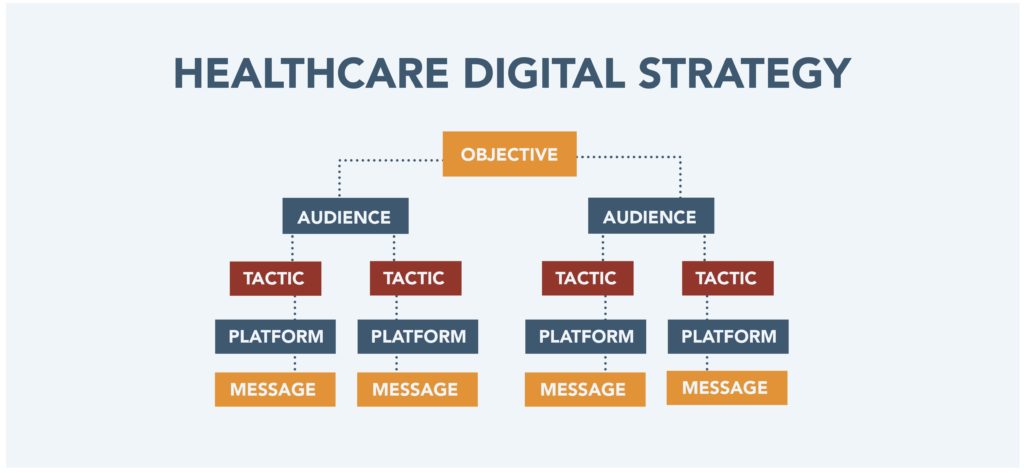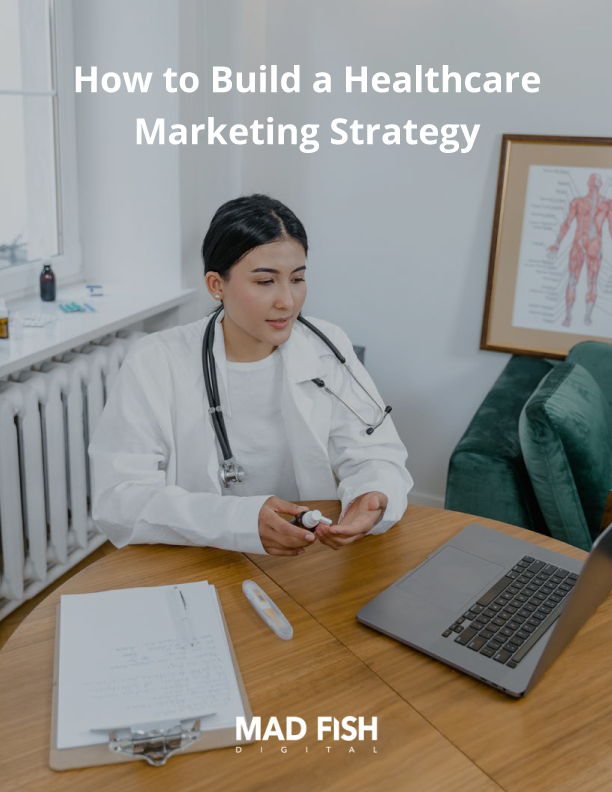Healthcare brands are increasingly competing in an over-saturated digital world. Without a comprehensive digital marketing strategy, hospitals and medical brands can find themselves falling behind competitors. In today’s environment of 24/7 content consumption, it’s crucial for hospital marketers to stay up-to-date with current trends in order to build their reputation and keep up with consumers’ expectations.
As healthcare marketers, it’s important to balance the reputation of the health system, the sensitivity of the topic, and the needs of your audience. For a strong marketing plan, a strategist must consider five key components:
- Objective
- Audience
- Tactic
- Platform
- Message
Here we share how healthcare marketers must assess the differences in each of these components in order to create a successful digital marketing strategy in your industry.
Different objectives require different marketing funnels
For many healthcare brands with B2C objectives like connecting patients with virtual care or booking online appointments, leading your audience from awareness, to consideration and ultimately action (ACT) through your promotion efforts works well. For brands with B2B objectives like creating awareness in the marketplace or lengthy lead generation cycles, something like the AIEDP funnel (Awareness/Interest/Evaluation/Decision/Purchase) applies just as well. There are many different variations of these funnels, but it can be difficult to plan relevant messaging to target your audience without having a clear set of steps defined.
For any funnel, the awareness phase is typically the most common starting point. Many marketers want to focus right on the last step of the funnel, but it is this first step where the magic begins. For B2C marketing, the awareness phase is often best served by content that educates patients on their condition and treatment options. The consideration phase for a B2B target market might be more about educating them on how the product could help solve one of their business challenges or why your brand’s product is better suited for your healthcare audience than others in the industry.
Different audiences use different platforms
Audience research should always be the first step in the strategy development phase. Knowing more about your patients and which digital platforms they use to get their information is pivotal when connecting to people at the ideal moment in their healthcare research. It’s critical to identify when in the decision-making process it makes the most sense to connect people with your health system, service, healthcare professional, or product.
Whether it is a patient searching for care, or a software-as-a-service company connecting with a decision-maker for a hospital system, understanding who you are looking for, and where they get their information is critical to a high-performing marketing strategy.
It’s important to note that not all audiences are the same. As marketers, our job is to create a digital strategy for each of your patient types or audience segments and their most used platforms (social media channels, websites, media, etc.) so we can effectively deliver information where it matters and at the right time. People make decisions at different points. As a healthcare provider, you want to help them make informed decisions about the healthcare they want or need at the right point.
Different tactics yield different results
If your goal is generating new patients for your clinics, then you should research what marketing tactics will be best suited for this specific objective. For example, content marketing on top of paid advertising campaigns might yield better results when looking specifically at generating leads through an online form submission process where you are reaching high-intent individuals who know exactly what they’re looking for.
Some hospitals have been successful at increasing their brand awareness by creating a unique voice and tone within digital media channels. However, it is not always easy to develop this for every hospital or medical group. In this case, it may be that content promotion around specific niche services may better speak to a target audience.
Knowing your audience segment will help determine who you should be targeting with what type of content in order to create engagement around the product category and drive the most qualified leads through these marketing channels.
Different platforms serve different target audiences with varying audience intent
Different platforms and networks will have different target audiences. Varying how you use these channels allows you to reach your customers in the right place, at the right time with the best message for their needs.
 Identifying your target audience personas, and the channels they use is crucial in meeting your audience where they are, with messaging that aligns with their needs. This is the center of a good channel strartegy. Understanding how each platform is used differently by its audience also helps you get an idea of what content might work best on those channels. For instance, the way a person interacts with the feed on Facebook is much different than the way that same person uses a Pinterest board, or even how they use Nextdoor.
Identifying your target audience personas, and the channels they use is crucial in meeting your audience where they are, with messaging that aligns with their needs. This is the center of a good channel strartegy. Understanding how each platform is used differently by its audience also helps you get an idea of what content might work best on those channels. For instance, the way a person interacts with the feed on Facebook is much different than the way that same person uses a Pinterest board, or even how they use Nextdoor.
Customized market research allows agencies like ours to understand the audience segments for each healthcare system, and which search and social ad platforms their audience are more likely to use for finding healthcare-related answers, services, and products. Once we have that data, our strategy team is able to then determine messaging strategies that address each stage of the marketing funnel we have defined for that specific platform.
With a solid healthcare marketing strategy in place, our team is able to create custom content for each channel. This includes creating social ads and messaging that aligns with a specific audience demographic and their needs. This also includes writing articles and visual content that will most resonate with an audience segment on that platform.
Through added features, agencies like Mad Fish Digital are further able to promote messages by identifying and layering 3rd party data sets on top of the basic social targeting helping to further refine how and where the right people receive messaging.
Different messages are needed for different stages
As a healthcare brand, it’s important to understand that you are not communicating with people at every stage of the buying cycle in the same way. It is essential to know who your audience is and speak to them in the right way if they are to be receptive to what you have to provide.
For instance, if someone just signed up for your email list and has never visited your website or shown any interest in booking an appointment, it wouldn’t make sense for you to send them emails with full details about an appointment that is currently available near them. Sending this person an introductory email that tells them how awesome your healthcare brand is, your approach to care and the specialty services lines you have available for patients will be much more effective. In this approach, you are speaking to where they’re at on their buyer journey.
Custom Digital Marketing Strategies for Healthcare
At Mad Fish Digital, we specialize in developing and executing custom digital marketing strategies built for the healthcare industry. Feel free to contact us to learn more. In the meantime, check out our guide to building a healthcare marketing strategy.



